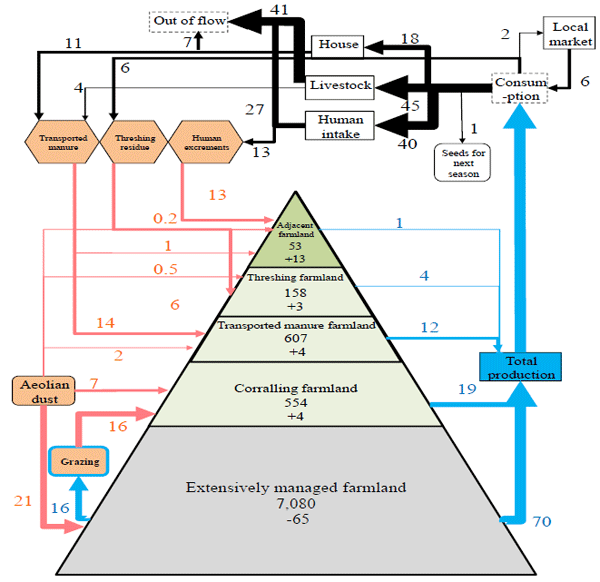Evaluation of nitrogen flow within the framework of farmland and village in the Sahel zone of West Africa
Description
The development of a suitable soil fertility management is of utmost important for the improvement of agricultural production in the Sahel zone of West Africa and effective utilization of locally available organic resources plays a vital role toward promoting appropriate management techniques for the existing low fertile sandy soil. Thus locally available organic resources should be quantitatively evaluated. In this regard, the JIRCAS project site in Niger, West Africa was identified as a benchmark of the study for the evaluation of nitrogen flow.
According to the survey, there are generally three categories in farmland management which are recycling, corralling and extensively managing farmlands. Recycling is the management method with household rubbish and farmyard manure, corralling is a traditional practice for pastoralists in the area to keep their livestock in the farm during the night, and extensively managing farmland is the method of rotation of fallow after certain years of cultivation. The category of recycling is sub-divided into three categories depending on the type of organic resources, i.e. adjacent farmland with household rubbish and human excrements, threshing farmland with threshed residues of millet, and a farmland using transported manure combined with household rubbish and farmyard manure.
Quantitative measurements were carried out on site for the crops’ biomass production, crop residues, transported manure and aeolian dust. The total number of livestock was obtained through an interview with pastoralists. A utilization method of harvested products was identified through a questionnaire for local households and other sources of the nitrogen flow were estimated through literature review.
Crop grains, stems and leaves, and wild plants were the removed wastes from farmlands and 66% in nitrogen out of the entire harvest was brought from the extensively managed farmlands. Despite the large amount of nitrogen removal, almost no complement was measured in there except aeolian dust which was in a small amount as compared with the removal. The nitrogen balance in this category was therefore estimated at -65t N year-1 (-9kg N ha-1 year-1).
Household rubbish and farmyard manure were brought mainly to the farmlands with the transported manure-type of recycling management but the use of farmyard manure was found to be ineffective due to the large amounts of nitrogen released to outside of the system. However, those adjacent farmlands were overloaded with nitrogen and the nitrogen balance was 4-13t N year-1 (7-245kg N ha-1 year-1). Therefore, it is imperative to develop a technology to enhance the judicious utilization of potential organic resources in the system.
Figure, table
- Affiliation
-
Japan International Research Center for Agricultural Sciences Crop Production and Environment Division
- Classification
-
Administration B
- Term of research
-
FY2009(FY2003~2010)
- Responsible researcher
-
HAYASHI Keiichi ( Crop Production and Environment Division )
MATSUMOTO Naruo ( Crop Production and Environment Division )
IKAZAKI Kenta ( Kyoto University )
KAKEN Researcher No.: 70582021SHINJO Hitoshi ( Kyoto University )
ORCID ID0000-0002-7244-9558KAKEN Researcher No.: 70359826TOBITA Satoshi ( Crop Production and Environment Division )
- ほか
- Publication, etc.
-
Hayashi et al. (2009) JARQ 43 (1):63-69
Hayashi et al. (2009) Abstracts of the annual meeting, Japanese Society of Soil Science and Plant Nutrition 55:14
- Japanese PDF
-
2009_seikajouhou_A4_ja_Part13.pdf225.84 KB

